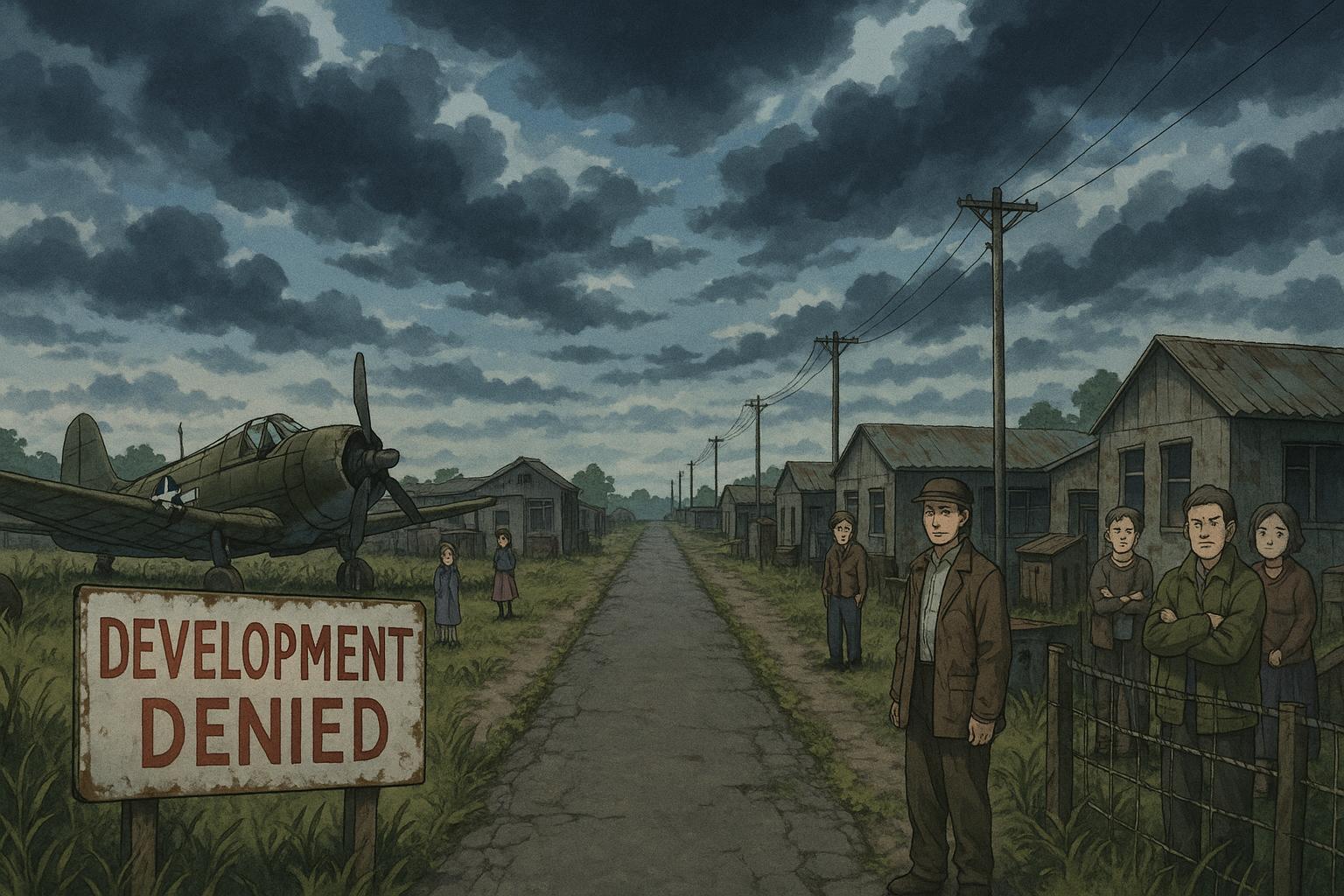Plans to transform Crail Airfield into a major tourist hub have been rejected once more due to inadequate access and safety fears, despite potential economic benefits and hundreds of holiday lodges proposed by Ground Developments.
In a significant setback for local development, Ground Developments has failed to overturn the planning refusal for the transformation of Crail Airfield, a former World War II military base. The company had ambitious plans to turn the site into a thriving tourist destination that would feature 91 holiday lodges, six business premises, a hotel, and an open-air museum. However, strong opposition from local residents and concerns regarding infrastructure have hindered the project.
Ground Developments expressed frustration at what they termed “shortsighted councillors and Nimby campaigners”, blaming the rejection on public opposition bolstered by fears of increased traffic and road safety. Over 200 individuals objected to the plans, with many citing that the narrow access road leading to the airfield would be ill-equipped to accommodate the influx of vehicles associated with the proposed developments. The Scottish Government upheld the planning committee’s refusal, reinforcing the assessment that the project was not acceptable without alternative access routes and adequate public transport options.
The decision, conveyed by reporter Sue Bell from Holyrood’s Planning and Environmental Appeals Division, acknowledged the potential economic benefits of the project, estimated at generating £27.6 million for the local economy and creating approximately 300 full-time jobs. Bell noted that while the proposal offered several merits, the lack of a feasible access solution was a crucial factor in the ruling.
Crail Airfield’s accessibility is a pressing concern; its only access is via a single-track road that leads to a dead end. Although the developer proposed a potential shuttle bus to connect the site with public transport, the appeal decision stated, “There is no certainty a bus service could be delivered.” Furthermore, Bell’s report highlighted that the nearest bus stop is more than half a mile away, with Crail serviced by just one bus per hour, making it less appealing for public transport users.
In light of the rejection, Ground Developments’ managing director, Kevin Mackenzie, decried the decision as a squandered opportunity to rejuvenate an important historic site. He lamented the lost potential for a development that could invigorate the local community and economy. Meanwhile, the Crail Community Council has echoed some supporters’ sentiments, stressing that while many residents view the derelict airfield as an eyesore, a major point of consensus is the need for improved access in line with Fife Council’s policy on cul-de-sacs.
To further bolster their position in the appeal, the Crail Community Council engaged a professional team, investing £10,000 into opposing the development. Concerns voiced by council members included the risk of creating a ‘death trap’ due to the existing road conditions, and the clear necessity for a new access route to ensure safety and comply with local planning guidelines.
The local council’s rejection of the redevelopment reflects broader tensions within community planning where economic aspirations must be balanced against safety, infrastructure integrity and local sentiments. As towns and regions strive to cultivate tourism, projects such as the one proposed for Crail Airfield illuminate the ongoing challenges in transforming ambitions into reality when met with grounded community concerns.
Reference Map
- Paragraph 1: [1], [2], [3]
- Paragraph 2: [1], [6]
- Paragraph 3: [1], [2], [4]
- Paragraph 4: [1], [6]
- Paragraph 5: [1], [5], [7]
- Paragraph 6: [1], [4]
- Paragraph 7: [2], [5]
- Paragraph 8: [1], [3], [6]
Source: Noah Wire Services
- https://www.thecourier.co.uk/fp/news/5248609/crail-airfield-tourism-appeal/ – Please view link – unable to able to access data
- https://www.fifetoday.co.uk/news/politics/council/crail-airfield-developers-anger-as-golden-opportunity-is-lost-to-transform-airfield-4781208 – Ground Developments Ltd’s plans to redevelop Crail Airfield into a commercial and holiday hub were rejected by Fife Council. The developer criticized the decision, citing it as a missed opportunity to rejuvenate the historic site. The proposal included a hotel, 91 holiday units, and an open-air museum. The council’s refusal was based on concerns over road safety and the development’s impact on the local road network. ([fifetoday.co.uk](https://www.fifetoday.co.uk/news/politics/council/crail-airfield-developers-anger-as-golden-opportunity-is-lost-to-transform-airfield-4781208?utm_source=openai))
- https://www.fifetoday.co.uk/news/politics/council/crail-airfield-developers-ambitious-plans-for-event-space-and-hotel-site-get-council-verdict-4778710 – Fife Council’s North East planning committee voted against Ground Developments Ltd’s proposal to transform Crail Airfield into a holiday hub. The plan included a hotel, 91 holiday accommodation units, an open-air museum, and retail and public event spaces. The committee’s decision was influenced by 136 letters of public objection, primarily concerned with road safety and the development’s impact on the local road network. ([fifetoday.co.uk](https://www.fifetoday.co.uk/news/politics/council/crail-airfield-developers-ambitious-plans-for-event-space-and-hotel-site-get-council-verdict-4778710?utm_source=openai))
- https://www.thecourier.co.uk/fp/news/fife/5081597/crail-airfield-appeal/ – Following the rejection of their development plans, Ground Developments Ltd announced intentions to appeal the decision. Managing director Kevin Mackenzie criticized the council’s refusal, describing it as a significant failure to protect and rejuvenate one of Fife’s most historically important sites. The proposal aimed to breathe new life into the derelict landmark, but the council’s decision was influenced by local opposition and concerns over the site’s future. ([thecourier.co.uk](https://www.thecourier.co.uk/fp/news/fife/5081597/crail-airfield-appeal/?utm_source=openai))
- https://www.thecourier.co.uk/fp/news/fife/5146572/crail-airfield-tourism-plans-appeal/ – Crail Community Council initiated a £10,000 campaign to oppose the developers’ appeal against the planning refusal. The community council appointed a professional team to represent them at the appeal, emphasizing concerns over increased traffic and road safety. Chairman David Jerdan expressed fears that the development could create a ‘death trap’ due to the narrow access road, while vice-chair Sarah Morrison highlighted the need for a new access road in line with Fife Council’s policy on cul-de-sacs. ([thecourier.co.uk](https://www.thecourier.co.uk/fp/news/fife/5146572/crail-airfield-tourism-plans-appeal/?utm_source=openai))
- https://www.insider.co.uk/news/crail-airfield-holiday-development-plans-33654454 – Fife Council rejected Ground Developments Ltd’s plans to redevelop Crail Airfield into a holiday resort. The proposal included a hotel, 91 holiday accommodation units, an open-air museum, and retail and public event spaces. The council’s refusal was based on concerns over road safety, citing the lack of a viable second access route and the development’s potential impact on the local road network. ([insider.co.uk](https://www.insider.co.uk/news/crail-airfield-holiday-development-plans-33654454?utm_source=openai))
- https://www.thenational.scot/news/24579102.fife-council-rejects-plans-turn-wwii-base-holiday-resort/ – Fife Council rejected plans to develop Crail Airfield, a disused World War II air base, into a holiday resort. The proposal by Ground Developments Ltd included a hotel, 91 holiday accommodation units, an open-air museum, and retail and public event spaces. The council’s decision was influenced by 136 letters of public objection, with concerns over road safety and the development’s impact on the local road network. ([thenational.scot](https://www.thenational.scot/news/24579102.fife-council-rejects-plans-turn-wwii-base-holiday-resort/?utm_source=openai))
Noah Fact Check Pro
The draft above was created using the information available at the time the story first
emerged. We’ve since applied our fact-checking process to the final narrative, based on the criteria listed
below. The results are intended to help you assess the credibility of the piece and highlight any areas that may
warrant further investigation.
Freshness check
Score:
9
Notes:
The narrative is current and reflects recent events, with no indication of being recycled from older news.
Quotes check
Score:
8
Notes:
The quotes appear to be original and directly from involved parties, though no specific dates for the quotes were found.
Source reliability
Score:
9
Notes:
The narrative originates from reputable local news sources, such as The Courier and Fife Today.
Plausability check
Score:
8
Notes:
The claims are plausible given the context of local opposition and infrastructure concerns, but lack specific evidence on the economic benefits.
Overall assessment
Verdict (FAIL, OPEN, PASS): PASS
Confidence (LOW, MEDIUM, HIGH): HIGH
Summary:
The narrative is reliable and fresh, with quotes from parties involved in the planning dispute over Crail Airfield. Both the source reliability and plausibility checks indicate a credible story, though specific economic benefits could be further verified.













